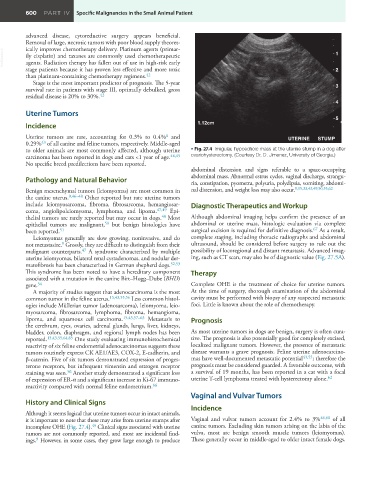Page 622 - Withrow and MacEwen's Small Animal Clinical Oncology, 6th Edition
P. 622
600 PART IV Specific Malignancies in the Small Animal Patient
advanced disease, cytoreductive surgery appears beneficial.
Removal of large, necrotic tumors with poor blood supply theoret-
ically improves chemotherapy delivery. Platinum agents (primar-
VetBooks.ir ily cisplatin) and taxanes are commonly used chemotherapeutic 1
agents. Radiation therapy has fallen out of use in high-risk early
stage patients because it has proven less effective and more toxic 2
than platinum-containing chemotherapy regimens. 42
Stage is the most important predictor of prognosis. The 5-year
survival rate in patients with stage III, optimally debulked, gross 3
42
residual disease is 20% to 30%.
4
Uterine Tumors
5
Incidence 1.12cm
6
Uterine tumors are rare, accounting for 0.3% to 0.4% and UTERINE STUMP
0.29% of all canine and feline tumors, respectively. Middle-aged
43
to older animals are most commonly affected, although uterine • Fig. 27.4 Irregular, hypoechoic mass at the uterine stump in a dog after
carcinoma has been reported in dogs and cats <1 year of age. 44,45 ovariohysterectomy. (Courtesy Dr. D. Jimenez, University of Georgia.)
No specific breed predilections have been reported.
abdominal distension and signs referable to a space-occupying
Pathology and Natural Behavior abdominal mass. Abnormal estrus cycles, vaginal discharge, strangu-
ria, constipation, pyometra, polyuria, polydipsia, vomiting, abdomi-
Benign mesenchymal tumors (leiomyomas) are most common in nal distension, and weight loss may also occur. 9,15,33,43,49,50,55,62
the canine uterus. 9,46–48 Other reported but rare uterine tumors
include leiomyosarcoma, fibroma, fibrosarcoma, hemangiosar- Diagnostic Therapeutics and Workup
coma, angiolipoleiomyoma, lymphoma, and lipoma. 47,49 Epi-
thelial tumors are rarely reported but may occur in dogs. Most Although abdominal imaging helps confirm the presence of an
48
epithelial tumors are malignant, but benign histologies have abdominal or uterine mass, histologic evaluation via complete
50
67
been reported. 51 surgical excision is required for definitive diagnosis. As a result,
Leiomyomas generally are slow growing, noninvasive, and do complete staging, including thoracic radiographs and abdominal
9
not metastasize. Grossly, they are difficult to distinguish from their ultrasound, should be considered before surgery to rule out the
47
malignant counterparts. A syndrome characterized by multiple possibility of locoregional and distant metastasis. Advanced imag-
uterine leiomyomas, bilateral renal cystadenomas, and nodular der- ing, such as CT scan, may also be of diagnostic value (Fig. 27.5A).
matofibrosis has been characterized in German shepherd dogs. 52,53
This syndrome has been noted to have a hereditary component Therapy
associated with a mutation in the canine Birt–Hogg–Dube (BHD)
gene. 54 Complete OHE is the treatment of choice for uterine tumors.
A majority of studies suggest that adenocarcinoma is the most At the time of surgery, thorough examination of the abdominal
common tumor in the feline uterus. 15,43,55,56 Less common histol- cavity must be performed with biopsy of any suspected metastatic
ogies include Müllerian tumor (adenosarcoma), leiomyoma, leio- foci. Little is known about the role of chemotherapy.
myosarcoma, fibrosarcoma, lymphoma, fibroma, hemangioma,
lipoma, and squamous cell carcinoma. 15,43,57–63 Metastasis to Prognosis
the cerebrum, eyes, ovaries, adrenal glands, lungs, liver, kidneys,
bladder, colon, diaphragm, and regional lymph nodes has been As most uterine tumors in dogs are benign, surgery is often cura-
reported. 15,43,55,64,65 One study evaluating immunohistochemical tive. The prognosis is also potentially good for completely excised,
reactivity of six feline endometrial adenocarcinomas suggests these localized malignant tumors. However, the presence of metastatic
tumors routinely express CK AE1/AE3, COX-2, E-cadherin, and disease warrants a grave prognosis. Feline uterine adenocarcino-
β-catenin. Five of six tumors demonstrated expression of proges- mas have well-documented metastatic potential 43,55 ; therefore the
terone receptors, but infrequent vimentin and estrogen receptor prognosis must be considered guarded. A favorable outcome, with
staining was seen. Another study demonstrated a significant loss a survival of 19 months, has been reported in a cat with a focal
56
62
of expression of ER-α and a significant increase in Ki-67 immuno- uterine T-cell lymphoma treated with hysterectomy alone.
66
reactivity compared with normal feline endometrium.
Vaginal and Vulvar Tumors
History and Clinical Signs
Incidence
Although it seems logical that uterine tumors occur in intact animals,
it is important to note that these may arise from uterine stumps after Vaginal and vulvar tumors account for 2.4% to 3% 46,68 of all
49
incomplete OHE (Fig. 27.4). Clinical signs associated with uterine canine tumors. Excluding skin tumors arising on the labia of the
tumors are not commonly reported, and most are incidental find- vulva, most are benign smooth muscle tumors (leiomyomas).
ings. However, in some cases, they grow large enough to produce These generally occur in middle-aged to older intact female dogs.
9

